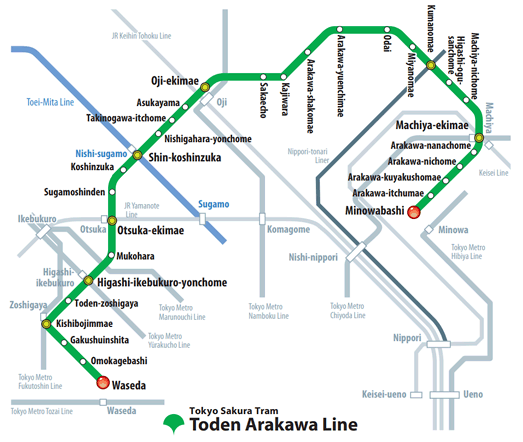Toden Arakawa
Tokyo Sakura Tram Tramway Line
Toden Arakawa (or Tokyo Sakura Tram) is a tramway line operating in the north of the Japanese capital and connecting the wards of Arakawa, Kita, Toshima and Shinjuku. Along a twelve-kilometer course between Minowabashi to Waseda, several stops are among the most beautiful places in Tokyo to enjoy cherry blossoms in spring.
Away from the bustling touristic sites, Toden Arakawa tramway offers a trip in a timeless and more authentic Tokyo, preserved from large scale urbanization.
The tramway line in the north of the capital
Benefiting of its own railways, the tramway is not stopped by traffic jams and travels through a variety of landscapes, from quiet residential districts to large avenues and shopping areas.
The tram’s course covers a half-loop on 12,2 kilometers in the north of the capital, and includes 30 stops, from Waseda (in the west) to Minowabashi (in the east):
- Waseda
- Omokagebashi
- Gakushuinshita
- Kishibojimmae
- Toden-zoshigaya
- Higashi-ikebukuro-yonchome
- Mukohara
- Otsuka-ekimae
- Sugamoshinden
- Koshinzuka
- Shin-koshinzuka
- Nishigahara-yonchome
- Takinogawa-itchome
- Asukayama
- Oji-ekimae
- Sakaecho
- Kajiwara
- Arakawa-shakomae
- Arakawa-yuenchimae
- Odai
- Miyanomae
- Kumanomae
- Higashi-ogu-sanchome
- Machiya-nichome
- Machiya-ekimae
- Arakawa-nanachome
- Arakawa-nichome
- Arakawa-kuyakushomae
- Arakawa-itchumae
- Minowabashi
The complete map:

The oldest sections of Toden Arakawa line were built in 1913, a time when the main transportation means in Tokyo was the tramway. At its peak in the first half of the 1940s, Tokyo tramway was used by almost two million travelers per day, on several lines. But the advent of cars 🚙 and subway 🚇, and the transportation infrastructures remodeling for 1964 Olympic Games 🏅, have caused this transportation method to deprecate slowly.
In 2017, the Tokyo Metropolitan Bureau of Transportation (Toei) that operates the last remaining tramway line Toden Arakawa reckoned 48,000 travelers per day. On the same year, and to highlight the numerous blooming cherry trees spots along its course, the tramway got the official nickname of Tokyo Sakura 🌸 Tram. Moreover, people living along the line take great care of growing roses 🌹 that ensure beautiful sceneries in May. Tokyo tramway users see that this line is maintained, as it is almost unique in the capital, with Tokyu Setagaya light rail line.

What are the most interesting tram stations for hanami in Tokyo?
Several tram stations are worth the visit, either to admire the blooming cherry trees in spring or to discover nice places in Tokyo:
- Arakawa-nichome (荒川二丁目). This stop is incredible as soon as getting of the tram, with dozens of wonderful cherry trees lining the tram station, as if in a postcard! The neighboring park Shizen Koen offers a nice short walk amidst ponds with a view on Tokyo SkyTree in the background.
- Arakawa-nanachome (荒川七丁目) serves a residential area with small shops and an enchanting provincial atmosphere.
- Arakawa-yuenchimae (荒川遊園地前) is the access to the eponymous amusement park for children, on the bank of Sumida River. The park has been renovated and reopened in spring 2022.
- Oji-ekimae (王子駅前) is a tram station in the heart of a large residential area in the north of Tokyo. It is home to several interesting spots such as Otonashi Water Park, Shakujii River bordered by numerous sakura trees and the beautiful shrine Oji Inari-jinja.
- Asukayama (飛鳥山) is also the main entrance to the eponymous public park, one of the most beautiful sakura spots in the capital. A unique tiny cable car transports to the highest point of the park.
- Shin-koshinzuka (新庚申塚) or Koshinzuka (庚申塚) allow a quick access to Sugamo Jizodori, a shopping avenue dedicated to senior citizens and nicknamed the "Grandma’s Harajuku." There, you can shop for unusual items such as red underwear to ensure for good health and a long life. In the same vein, don’t forget to pay a visit to Togenuki Jizo in Kogan-ji temple.
- Omokagebashi (面影橋) offers astounding views on Kanda River banks, engulfed in flowers in spring. We recommend walking to Chinzan-so gardens, then to Higo-Hosokawa Teien, two refined and beautiful gardens that few foreign tourists know. The sakura journey ends in Edogawa Park where many Japanese tourists come to picnic in a laid-back atmosphere.
The pace between the tramway stations is slow. Daily passengers enjoy this soft transportation method that allows a leisurely contemplation of the scenery.
Every little detail of the trip is important and part of the experience in Tokyo Tram. Once comfortably seated in the small carriage, you will hear the bells ringing to warn of the departure. Then the music goes on with the melodies at the safety barriers blocking traffic where the road and the rails cross, in a unique sound ambiance.
Toden Arakawa offers an insight on the peaceful life of residential and popular areas in the center of Tokyo.

